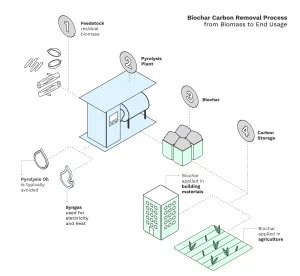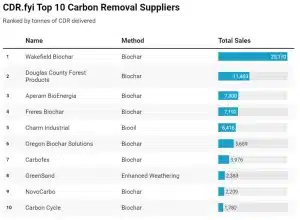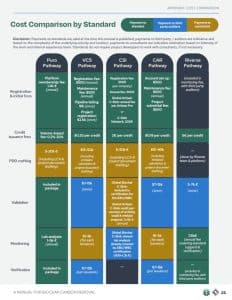Hamerkop and the International Biochar Initiative (IBI) have unveiled a comprehensive guide titled “A Manual for Biochar Carbon Removal,” aimed at biochar producers, investors, and stakeholders. This manual compares certification standards, provides practical project design guidance, and details associated costs. Thus, it facilitates a clearer understanding of biochar carbon removal and certification processes.
Hamerkop, an advisory firm specializing in climate finance, carbon offsetting, and energy access, partnered with IBI to create this manual. It serves as an essential roadmap, offering insights into the certification of biochar carbon removal credits and aiding participants in navigating the complexities of biochar certification and various standards available in the market.
How Capable is Biochar in Sequestering Carbon?
Biochar, a carbon-rich material produced from organic matter through pyrolysis, has garnered significant attention for its carbon sequestration potential. Unlike natural decomposition, which releases greenhouse gases (GHGs), transforming biomass into biochar locks carbon into a stable form.
As such, it prevents carbon release and allows it to be stored for centuries. This property makes biochar a potent tool in combating climate change.

The manual introduces biochar and its role in the voluntary carbon market, where biochar projects can generate carbon removal credits. These credits can be sold to companies seeking to offset their carbon emissions, thus providing a financial incentive for biochar production.
- Certification plays a crucial role in ensuring the credibility and effectiveness of biochar carbon removal efforts, which the manual underscores.
A significant section of the manual is dedicated to comparing existing biochar methodologies and standards, including:
- Puro.earth,
- Verified Carbon Standard (VCS),
- Carbon Standards International (CSI), Riverse, and
- Climate Action Reserve (CAR).
By evaluating these standards, the guide helps biochar producers and investors choose the most appropriate approach for their specific projects.
Comparing Biochar Standards
The manual details the criteria and requirements of each standard, such as eligible feedstocks, production technologies, and end-use applications. For instance, Puro.earth mandates rigorous audits and detailed records of carbon removal activities, while Verra’s VCS ensures biochar projects are additional and not part of business-as-usual operations. CSI, on the other hand, offers methodologies tailored for both large-scale and small-scale biochar production.
In addition to providing an overview of certification standards, the manual offers practical guidance on designing biochar projects. It covers considerations such as project scale, biomass feedstock selection, production technologies, and end-use applications, assisting project developers in creating robust and effective biochar carbon removal initiatives.
The manual also highlights the variability of biochar properties based on feedstock and production parameters. Different feedstocks can yield biochar with varying carbon content, nutrient availability, and physical properties.
The guide discusses how these variations impact the carbon sequestration potential and other benefits of biochar, such as soil improvement and water retention.
More notably, a cost comparison of the various certification pathways is included to help stakeholders budget for their biochar projects. The guide details fees associated with each standard, including registration, audit, and issuance costs, providing a comprehensive understanding of the financial implications of biochar certification.
The infographics below, first shared by Olivier Levallois in LinkedIn, details the cost comparison per biochar standard.
By offering a calibrated analysis of different carbon accounting methods and providing clear, practical guidance, the manual aims to simplify the process for biochar producers and investors. This, in turn, promotes the growth of the biochar industry as a viable solution for reducing greenhouse gas emissions and mitigating climate change.
Biochar’s Rapid Expansion and Projections
The guide’s release comes at a crucial time as the world seeks effective solutions to mitigate climate change. Biochar’s ability to sequester carbon and improve soil health makes it a promising option.
Biochar has emerged as a prominent technology for durable carbon dioxide removal (CDR). It has the potential to remove up to 6% of global emissions annually.
In 2023, biochar carbon removal accounted for over 90% of delivered carbon credits, according to CDR.fyi. Currently, the biochar industry produces at least 350,000 metric tonnes annually and is on a steep growth trajectory. By 2040, the industry aims to deliver a gigaton of biochar carbon removal.

This rapid expansion is driven by strong industry optimism and significant financial projections. Revenues are expected to skyrocket from $600 million in 2023 to nearly $3.3 billion by 2025. This growth reflects the increasing recognition of biochar’s role in combating climate change and its value in the carbon credit market.
The industry’s optimistic outlook and robust growth trajectory highlight biochar’s potential as a key player in global carbon removal efforts.
The collaboration between Hamerkop and the International Biochar Initiative underscores the importance of stakeholder engagement and industry best practices in advancing biochar as a sustainable carbon removal strategy.



